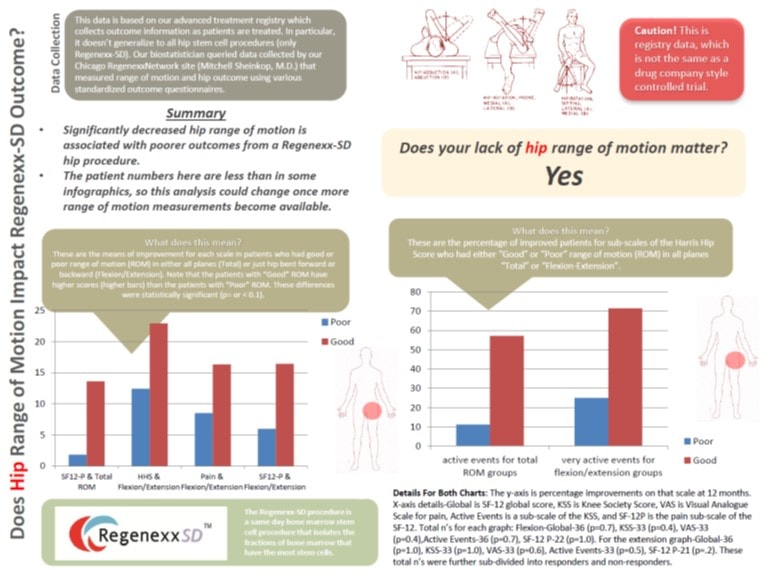Does Hip Range of Motion Impact the Outcome of a Hip Stem Cell Procedure?
We have evaluated and treated hundreds of patients with hip arthritis with their own stem cells since 2005. One of the trends we’ve noted as doctors, is that poor hip range of motion may be a poor prognostic sign. Hip range of motion is lost quickly in many degenerative hip patients, so this has always been a nagging concern. Recently we looked at the range of motion data contained in Dr. Sheinkop’s data set, as the outcome measure he used required range of motion. What did we find? There was a statistically significant correlation between poor hip range of motion and worse outcomes for the Regenexx-SD procedure, similar to the one we noted for hip stem cell treatments and older age.
Why is this likely happening? Unlike a knee joint, where significant range of motion loss is uncommon, arthritic hips are more commonly locked in place. While a hip with good movement allows the force of the body weight to be distributed across a wide surface area as you walk or run, a “locked in” hip focuses that force on one small area which is already having issues due to arthritis.
The upshot? While poor range of motion in the knee wasn’t a big deal and didn’t hurt stem cell treatment outcomes (likely because few patients have enough range of motion loss there to make a big difference in how they move or bear weight in the joint), poor range of motion will be a headwind in a hip stem cell procedure. We are working on innovative new injection methods to address this issue and hopefully one of them (i.e. percutaneous capsuloplasty) will help solve this problem. In the meantime, based on our historical registry data, hip patients tend to respond better to the cultured stem cell procedure when compared to a same day procedure. In addition, recognize that since the numbers in this analysis are small, a later analysis with bigger numbers may draw different conclusions. As always, the full PDF can be accessed by clicking on the picture above or here.

NOTE: This blog post provides general information to help the reader better understand regenerative medicine, musculoskeletal health, and related subjects. All content provided in this blog, website, or any linked materials, including text, graphics, images, patient profiles, outcomes, and information, are not intended and should not be considered or used as a substitute for medical advice, diagnosis, or treatment. Please always consult with a professional and certified healthcare provider to discuss if a treatment is right for you.

